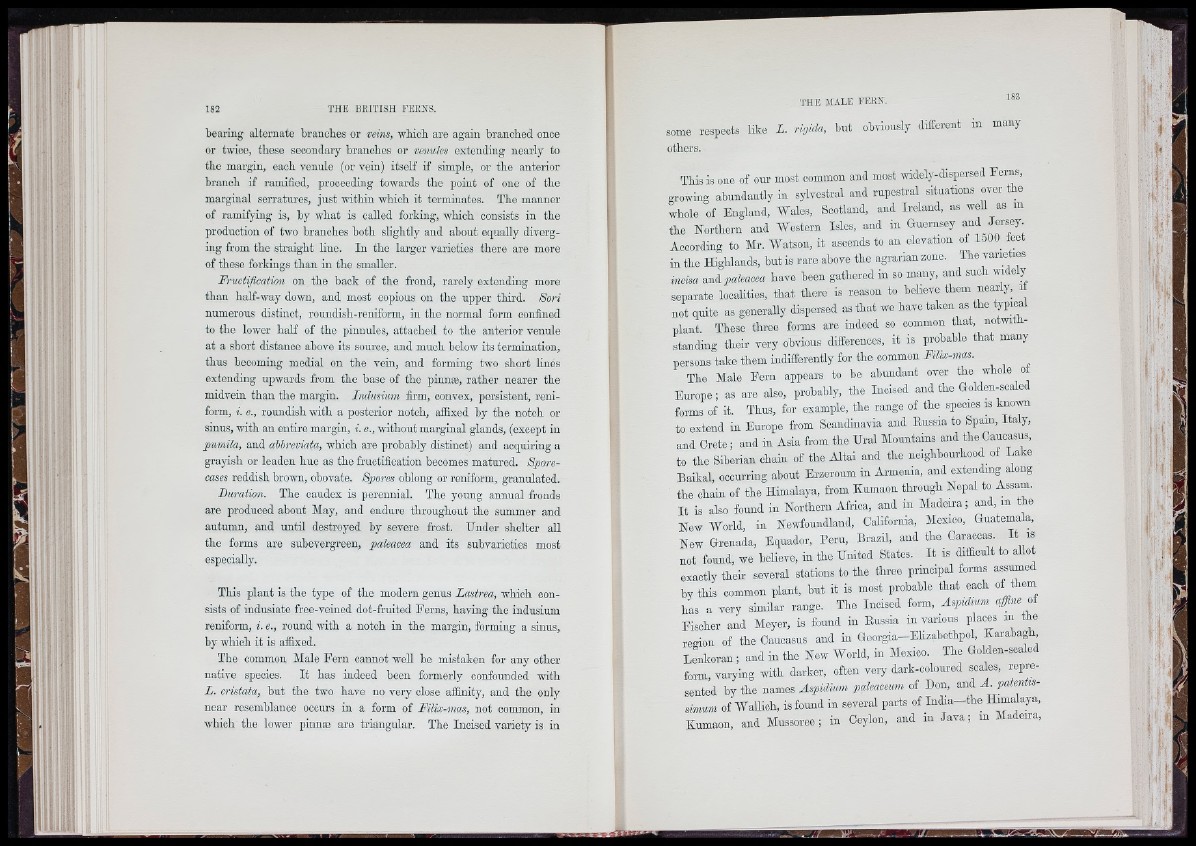
I
! I'
; • bearing alternate branches or veins, which are again branched once
or twice, these secondary branches or venules extending nearly to
tho margin, each venule (or vein) itself if simjile, or the anterior
branch if ramified, proceeding towards the point of one of the
marginal serratures, just within which it terminates. The manner
of ramifying is, by what is called forking, which consists in the
production of two branches both slightly and about equally diverging
from the straight line. In the larger varieties there are more
of these forldngs than in the smaller.
Fructification on the back of the frond, rarely extending more
than half-way down, and most copious on the upper third. Sori
numerous distinct, roundish-reniform, in the normal form confined
to the lower half of the pinnules, attached to the anterior venule
at a short distance above its source, and much below its termination,
thus becoming medial on the vein, and forming two short lines
extending upwards from the base of the pinnæ, rather nearer the
midvein than the margin. Indusium firm, convex, persistent, reniform,
i. e., roundish with a posterior notch, affixed by the notch or
sinus, with an entire margin, i. e., without marginal glands, (except in
pumila, and abbreviata, which are probably distmct) and acquiring a
grayish or leaden hue as the fructification becomes matured. Spore-
cases reddish brown, obovate. Spores oblong or reniform, granulated.
Duration. The caudex is perennial. The young annual fronds
are produced about May, and endure throughout the summer and
autumn, and until destroyed by severe frost. Under shelter all
the forms are suhevergreen, paleacea and its subvarieties most
especially.
; i
This plant is the type of the modern genus Lastrea, which consists
of indusiate free-veined dot-fruited Ferns, having the indusium
reniform, i. e., round with a notch in the margin, forming a sinus,
by which it is affixed.
The common Male Forn cannot well he mistaken for any other
native species. I t has indeed been formerly confounded with
L. cristata, hut the two have no very close affinity, and the only
near resemblance occurs in a form of Filix-mas, not common, in
which the lower pinnæ are triangular. The Incised variety is in
some respects like L. rigida, hut obviously different iu many
others.
This is one of our most common and most widely-dispersed Ferns,
growing abundantly in sylvestral and rupestral situations over the
whole of England, Wales, Scotland, and Ireland, as weU as in
the Northern and Western Isles, and in Guernsey “ id Jersey
According to Mr. Watson, it ascends to an elevation of loOO^ toet
in tho Highlands, hut is raro above tho agrarian zone. The varieties
incisa and paleacea have been gathered in so many, and such wide y
separate localities, th a t there is reason to believe them nearly, if
not quite as generally dispersed as th a t we havo taken as the typical
plant These three forms aro indeed so common that, notwitn-
standing their very obvious differences, it is probable th a t many
persons take them indifferently for the common F if a -« « .
The Male Fern appears to be abundant over the w o e o
Europe; as are also, probably, the Incised and the Golden-scaled
forms of it. Thus, for example, the range of the species m known
to extend in Europe from Scandinavia and Eussia to Spam, Italy,
and Crete; and in Asia from the Ural Mountains and the Cauoasns,
to the Siberian chain of the Altai and the neighbourhood of Lake
Baikal, occurring about Erzeroum in Armenia, and extending along
the chain of the Himalaya, from Kumaon through Nepal to Assam.
I t is also found in Northern Africa, and in Madeira; and, in the
New World, in Newfoundland, California, Mexico, Guatemala,
New Grenada, Eqnador, Peru, Brazil, and the Caraocas. I t is
not found, we believe, in the Hnited States. I t is difficult to allot
exactly their several stations to the three principal forms assumed
by this common plant, but it is most probable that each of them
has a very similar range. The Incised form, Aspidium affine oi
Fischer and Meyer, is found in Eussia in various places m the
retrion of the Caucasus and in Georgia—Elizabethpol, Karabagh
Lenkoran ; and in the New World, in Mexico. The Golden-scaled
form, varying with darker, often very dark-coloured scales, represented
by the names Aspidium paleaceum of Don, and A . patentissimum
of Wallioh, is found in several parts of In d i a - th e Himalaya,
Kumaon, and Mussoree; in Ceylon, and m J av a ; m Madeira,
\ .
If.
kt;,; '-:-1
1 .11.1
?• I
'( I
n